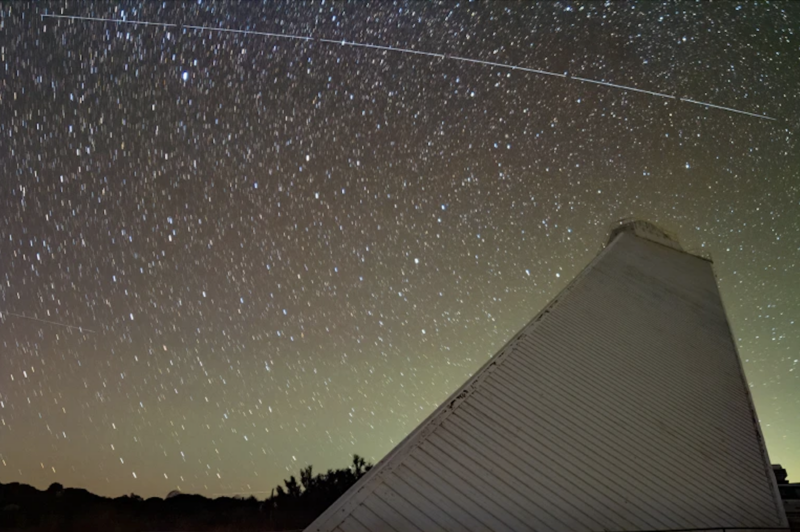
Astronomers – already suffering from noctalgia, aka sky grief or sadness at the loss of dark skies – had their worst fears confirmed this week when a new study showed that the BlueWalker 3 satellite can at times shine as brightly as 99% of all the stars. It shone this brightly twice during a months-long international optical observation campaign, designed to measure its impact on the night sky. AST SpaceMobile in Midland, Texas, launched the satellite in late 2022. It’s the largest communications satellite yet. And AST SpaceMobile plans to launch some 150 of these satellites in all.
The study was published in the peer-reviewed journal Nature on October 2, 2023.
An accompanying article in Nature said the satellite hit its maximum brightness (a magnitude of +0.4) when it first unfurled its 690-square-foot (64-square-meter) antenna in November of 2022. The Nature article explained:
If it were a star, it would have been one of the 10 brightest in the sky.
But its apparent brightness changes as the satellite rotates. And by late December, it had dimmed to a magnitude of +6 [barely at the limit of visibility to the unaided eye].
It then brightened again, reaching magnitude +0.4 once more on April 3, 2023.
How bright is it?
By comparison, the 8th-brightest star in the Northern Hemisphere – Procyon in Canis Minor – is barely brighter than BlueWalker 3 at its brightest.
The satellite is the same magnitude as 9th-brightest Achernar in the constellation Eridanus, another one of our sky’s brightest stars.
When shining at its brightest, BlueWalker 3 is easily visible to the unaided eye. To find out when it will be passing overhead from your location, check Heavens-Above.com.
New satellite has raised concerns before
AST SpaceMobile launched the massive satellite in September 2022. It’s meant to be a prototype for a satellite fleet designed to make mobile broadband available almost anywhere. Unfurled, this satellite is more than 26 feet per side (about 8 meters per side). That makes Bluewalker 3 the largest commercial communications satellite currently in low-Earth orbit. And it means BlueWalker 3 has the potential to reflect a huge amount of sunlight back toward Earth.
It’s a prototype. So you won’t be surprised to learn that AST SpaceMobile has plans to launch a lot of these satellites eventually. Last we heard, the plan was for six per month, with possibly more than 150 total.
BlueWalker 3 has raised worries within the world’s community of professional astronomers before this. In late 2022, the International Astronomical Union (IAU) issued an announcement, voicing its concerns about the satellite’s brightness.
The IAU on BlueWalker 3
The IAU said then it believed that Bluewalker 3 had become one of the brightest objects in our night sky. The new study – published this week in Nature – confirms that speculation.
It’s not just the visible brightness that astronomers find concerning. It’s also the strong radio waves that Bluewalker 3 and its successors will emit. These radio waves will interfere with the work of astronomers. The director-general of the Square Kilometer Array Observatory, Philip Diamond, said a year ago:
Astronomers build radio telescopes as far away as possible from human activity, looking for places on the planet where there is limited or no cell phone coverage. Frequencies allocated to cell phones are already challenging to observe even in radio quiet zones we have created for our facilities.
New satellites such as BlueWalker 3 have the potential to worsen this situation and compromise our ability to do science if not properly mitigated.
A statement from AST SpaceMobile
Dave Mosher from AST SpaceMobile reached out to EarthSky a year ago with a statement about BlueWalker 3:
AST SpaceMobile’s mission is to help solve the major global problem of lack of connectivity, which affects billions of people around the world. We are building the first and only space-based cellular broadband network; one that is designed to provide coverage to areas currently beyond the reach of today’s networks.
Our planned network aims to connect devices around the world and support a universal good. Cellular broadband for more people globally would help ease poverty, support economic development, build a more equitable and diverse digital society, and save lives.
We are eager to use the newest technologies and strategies to mitigate possible impacts to astronomy. We are actively working with industry experts on the latest innovations, including next-generation anti-reflective materials. We are also engaged with NASA and certain working groups within the astronomy community to participate in advanced industry solutions, including potential operational interventions.
As part of this work, AST SpaceMobile is committed to avoiding broadcasts inside or adjacent to the National Radio Quiet Zone in the U.S. and additional radio astronomy locations that are not officially recognized, as required or needed. We also plan to place gateway antennas far away from the National Radio Quiet Zone and other radio-quiet zones that are important to astronomy.
While other constellations may require thousands of satellites — there could be as many as 58,000 in orbit by 2030, according to a recent U.S. government report — we plan to provide substantial global coverage with a network of 168 or fewer satellites.
What is BlueWalker 3?
AST SpaceMobile appeared very proud of Bluewalker 3’s size when the satellite unfurled last year:
BW3 is the largest-ever commercial communications array deployed in low-Earth orbit and is designed to communicate directly with cellular devices via 3GPP standard frequencies at 5G speeds. Now that it has been unfolded, the satellite spans 693 square feet [64 square meters] in size, a design feature critical to support a space-based cellular broadband network. The satellite is expected to have a field of view of over 300,000 square miles [777,000 square kilometers] on the surface of the Earth.
Abel Avellan, Chairman and Chief Executive Officer of AST SpaceMobile, had said:
The successful unfolding of BlueWalker 3 is a major step forward for our patented space-based cellular broadband technology and paves the way for the ongoing production of our BlueBird satellites.
Array fully deployed in space!!!!
See photos from BlueWalker 3 unfolded in orbit with different sun angles. So proud of the team. ???????????????????????????????????????????????????????????????????????#5G pic.twitter.com/jC1GpR2fbz— Abel Avellan (@AbelAvellan) November 14, 2022
As bright as the Big Dipper
People have reported seeing Bluewalker 3 passing overhead in dark skies. And they have indeed compared it to some of the brightest stars. In the tweet below, you can see the satellite passing through the bowl of the Big Dipper. The short streak of light that is Bluewalker 3 looks every bit as bright as the 2nd-magnitude stars in the bowl.
@AST_SpaceMobile's very bright #bluewalker3 passed over our bay area imaging site early this morning at about 5:15 AM local (GMT-8). pic.twitter.com/IhscthdnfN
— Exclosure (@TheExclosure) November 12, 2022
Can you see BlueWalker 3? Sure!
If you want to see for yourself just how bright BlueWalker 3 is in your skies, visit Heavens-Above.com to find when it will pass over your area.
Note that the couple of hours after sunset and before sunrise are when you’ll have an opportunity to see Bluewalker 3.
EarthSky’s Kelly Kizer Whitt wrote:
I observed BlueWalker 3 for three nights in a row in late November 2022. On all three nights (November 20, 21 and 22), the satellite took a similar path across the sky and appeared close to 3rd magnitude. Each time it cut across the sky near Jupiter. When it was lower near the horizon, I was unable to spot it due to light pollution. Not until it was closer to 25 degrees high in the sky could I spot it from the background murk. Below is a simple, handheld iPhone video I took of one of the passes. You can spot the dim light (similar in brightness to other satellites) passing just below Jupiter:
I’ve spotted #BlueWalker3 2 nights in a row now. Not particularly bright. Here’s a poor quality iPhone video of it passing right below Jupiter tonight. pic.twitter.com/bUQTLOEdBA
— Kelly Kizer Whitt (@Astronomommy) November 22, 2022
Increasingly crowded skies
So the issue of increasing satellites in our skies is a complicated one. How can humans balance the racing technological advances but still preserve our dark skies?
Astronomers are trying to work with the satellite companies such as SpaceX with its burgeoning Starlink satellites to find some kind of compromise. You can read more here: How satellites harm astronomy: what’s being done.
Meanwhile, in recent weeks, astronomers have begun using a new word to describe how they feel about the loss of night skies to bright satellites. The word is noctalgia, which, they say, can be described as sky grief.
Bottom line: A new study – published in Nature on October 2, 2023 – confirms astronomers’ worst fears. The study confirmed that AST SpaceMobile’s satellite BlueWalker 3 does outshine 99% of the stars.
Astronomers have noctalgia (sky grief), or sadness at the loss of dark skies
Source: The high optical brightness of the BlueWalker 3 satellite











